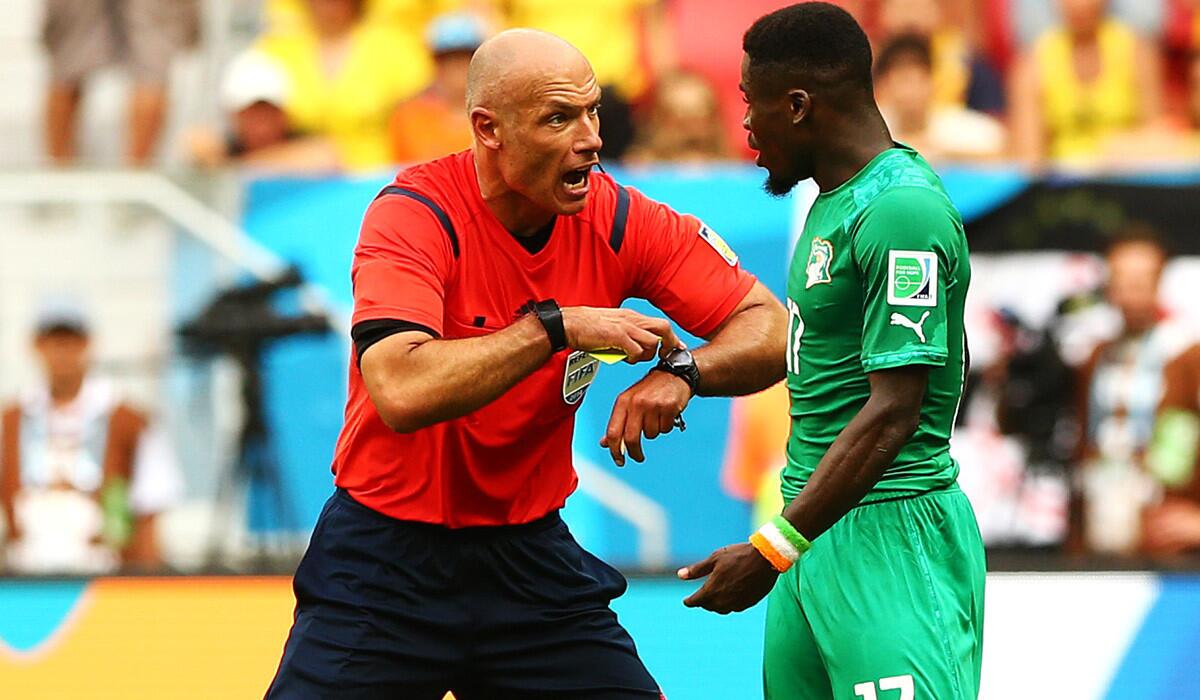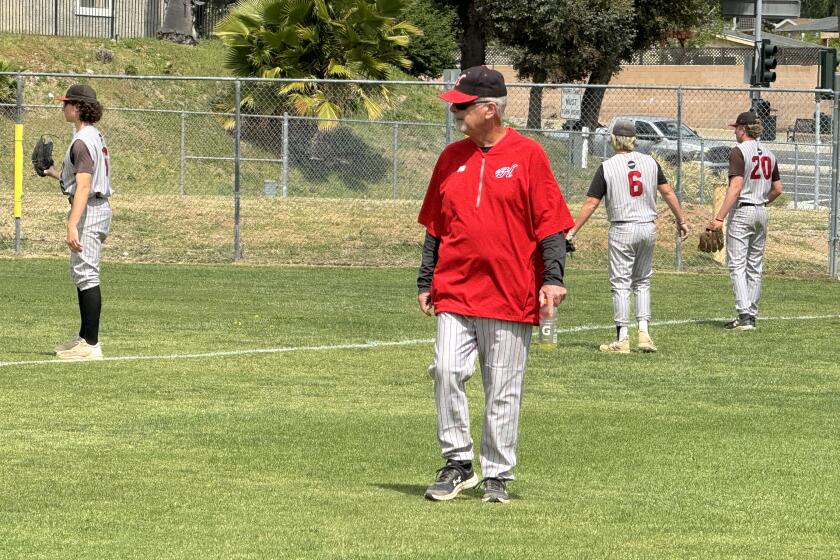In soccer, ‘stoppage time’ can lead to confusion and controversy

When John Brooks scored the goal that would give the United States a 2-1 victory over Ghana in its World Cup opener Monday, his teammates knew the end was near.
Exactly how near was the question.
Because there was no scoreboard clock in the stadium in Natal, Brazil, several U.S. players said after the match they had no idea exactly how much time was left when Brooks scored, which was in the 86th of the scheduled 90 minutes of regulation time.
The key word here is “scheduled.”
In soccer, a match almost never lasts only 90 minutes.
There is this unscheduled matter called “stoppage time” or “injury time,” which can be added at the officials’ discretion at the end of each half. In the U.S.-Ghana match, for instance, five minutes were added to the second half.
It is a concept whose origin is lost in the mists of time but one that the international soccer federation, FIFA, said has been part of the game since at least 1913. A century later, it is covered by a rule that is stunningly amorphous, leading to confusion, controversy and thrills.
The most exciting moment in U.S. men’s soccer history was the Landon Donovan goal in the first of four stoppage-time minutes against Algeria in the 2010 World Cup, giving his team the victory needed to make the second round.
Yet the whole thing remains hard to understand for U.S. fans, who through the World Cup are being drawn to the world’s sport for the first time. They are accustomed to basketball, football and hockey, sports whose clocks stop when play does and games end when the clock runs out, and to baseball, which has no clock but very specific rules about what constitutes a full game.
U.S. college soccer works like the more familiar sports, although Northwestern Coach Tim Lenahan said he expects the college game will eventually adopt international timekeeping rules as the U.S. moves closer to FIFA’s rules.
“It’s a weird one,” said Fire Coach Frank Yallop, an Englishman who played internationally for Canada, “and a bit of a mystery at times. But it has been done that way for ages, and you can’t change it just for the U.S.”
Until 18 years ago, the process was even more mysterious because only the referee knew how much time had been added.
FIFA finally decided the time had come to reveal the secret. With about one minute left in each half, an official comes to the sideline with an electronic clock board that displays the stoppage time to players, coaches and spectators, both live and watching on television. The boards were used for the first time at the 1996 European Championships and for the first time in a World Cup match two years later.
But the referee can add stoppage time within stoppage time. And even when all that added time ostensibly runs out, the game still may not be over, or, in soccer terminology, reached “full time.”
“Waiting to see the added time is an interesting feeling most people don’t understand,” said U.S. women’s national team star Alex Morgan, whose goal in the third minute of stoppage time after two overtimes beat Canada in the 2012 Summer Olympics semifinals.
“It’s something unlike any other sport. I love that uniqueness and the fact the referee has the power to decide exactly at what instant and on what play to call it. You can’t just expect the clock to help you in the final seconds. It’s a scary moment.”
According to Law 7 of soccer’s rules, known as the “Laws of the Games,” an “allowance is made in either period for all time lost through: substitutions; assessment of injury to players; removal of injured players from the field of play for treatment; wasting time; any other cause.”
And now the kicker: “The allowance for time lost is at the discretion of the referee.”
So is the decision to end the match. The referee can allow an attack to continue until it has produced a goal or fizzled out, no matter that, say, five minutes of stoppage time has run to six or seven.
“Stoppage time is very subjective,” Morgan said. “It always seems there is too much time added on when you are up a goal … and too little when you are behind.”
It is no surprise that the amount of added time is affected by circumstances such as a team’s stature or where the match is being played.
The Guardian, a British newspaper, studied 60 Manchester United home matches from 2006 to 2009 and found the powerhouse club got to play nearly a minute more when it was behind or tied than it did when it was ahead.
The fourth official keeps track of how much time has been lost and suggests to the referee the minimum that needs to be added back. It is usually 30 seconds for substitutions and goal celebrations and a minute for injuries.
“The referee remains the sole arbiter of time,” the FIFA media office said — and reiterated — in an email to the Tribune.
The referee never stops his watch, the match’s official clock, for the interruptions. The referee can add to the minimum stoppage time but never reduce it. The referee tells the fourth official how much stoppage time to display on the electronic board.
In England’s Premier League, fourth officials began making a written record of the lost time in the 2011-12 season. The FIFA regulations for the 2014 World Cup make no mention of such an accounting.
FIFA said in its email that there never have been discussions about eliminating stoppage time. The only discussions have focused on whether the amount of time added was appropriate.
“It might however be discussed whether proper timekeeping [of the time wasted] could be introduced,” the media office wrote.
With the frequent allegations of match fixing, there have been discussions about taking timekeeping out of the referee’s hands and giving it to an off-field official because the current system gives one person so much power and makes him a target for gamblers trying to buy a result.
“As an American, I kind of like an end and a beginning and knowing exactly where we are,” Lenahan said. “But there is an excitement about waiting for the 89th minute to see how much time is added. It’s part of the lore and allure of international soccer.”
Follow Philip Hersh on Twitter: @olyphil
Tribune Newspapers’ Kevin Baxter contributed to this report.
More to Read
Get our high school sports newsletter
Prep Rally is devoted to the SoCal high school sports experience, bringing you scores, stories and a behind-the-scenes look at what makes prep sports so popular.
You may occasionally receive promotional content from the Los Angeles Times.






